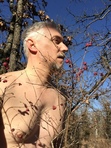Will Forest's Blog
July 17, 2025
The Naked Truth about the Huastecs
There’s a sprawling region along Mexico’s northern Gulf Coast called La Huasteca, comprising parts of seven states – Tamaulipas, San Luis Potosí, Veracruz, Puebla, Hidalgo and small sections of Querétaro and Guanajuato. It’s a lush, beautiful area of tropical lowlands, with raging rivers, plunging waterfalls, and massive cave systems. Ecotourism has been growing in the region in the past few decades, with well-known destinations including El Sótano de las Golondrinas (The Cave of Swallows). It’s also the Indigenous homeland of the Téenek, often still referred to as the Huastecs.
The Téenek are in fact the only Mayan group not located on or near the Yucatán peninsula. As happened often in the history of this hemisphere, the Europeans would trundle around, meet an Indigenous group, ask for the names of the neighboring Indigenous groups, and place those names into their chronicles, ensuring their historical impact. Yet often such names given by other groups (exonyms) meant things like ‘barbarians’ or ‘idiots’ or ‘savages,’ in comparison to the groups’ true names in their own languages (endonyms) which often meant ‘the people.’ Such is the case with the term Huastec, which the Nahuatl-speaking Mexica (Aztecs) and other peoples of central Mexico gave to the Téenek… because in Nahuatl it means ‘naked’ (a fact I learned at the Museo Regional Huasteco). In their steamy jungle lowlands, the Téenek did indeed live nude or top-free more often than not, which contrasted with the central Mexican societies’ regimented dress codes and need for clothing in their cooler, elevated clime. Most people (even most Mexicans) don’t know the etymology of the term, so it’s amusing to refer to this vast region of the country as, essentially, The Naked Region, or The Region Where People Barely Wear Clothes.
Appropriately, one of the region’s most important artifacts is a nude statue known as “El Adolescente de Tamuín,” roughly the Teen from Tamuín (this post’s feature photo above: source). The limestone sculpture, now housed at the Museo Nacional de Antropología in Mexico City, includes inscriptions along the proud young man’s front and back referring to the life cycles of humans and of corn. Another famous instance of a nude Téenek man comes from Nahuatl oral history. There is a tale told of a Huastec ‘tohuenyo’ (outsider or foreigner) who appeared at a market in the highlands of Tula selling chilies while nude. The sight of his ‘chili’ enamored the local princess, who became consumed with desire for him, to the extent that her father the king arranged their marriage, etc., but it turned out the chili vendor was the trickster god Tezcatlipoca in disguise. Chilies have long been stand-ins for penises in Indigenous stories and jokes.
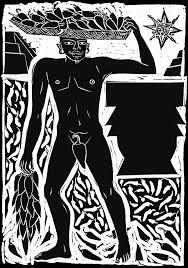 Illustration of El Tohuenyo by Joel Rendón and Alejandra Ríos Silva. Source.
Illustration of El Tohuenyo by Joel Rendón and Alejandra Ríos Silva. Source.Another interesting connection to nudity in the Huasteca region relates to one of the area’s attractions: the Edward James Sculpture Garden at Las Pozas, located near Xilitla. James was a British socialite and poet motivated by his love for orchids to buy land in the region in the late 1940s. After the landscape’s destruction due to a rare ice storm in 1962, he designed an oneiric “surrealist” garden, adding his whimsical architectural structures to the tropical abundance. It was often the local workers, speakers of Téenek and Nahuatl, who actually executed the reality of his vision, building the molds to shape the concrete following the general idea of what he would describe to them. According to a local guide who used to play with his childhood friends in the gardens before they became a park, James’ workers were required to sign a form stating that they would not be scandalized by his frequent lack of clothing. One wonders if any of the laborers decided to work clothesfree as well!


One of the structures in Las Pozas is a temazcal decorated as a turtle. The temazcal is a widespread kind of round Mesoamerican sweat lodge made of clay or stone, like a sauna, in which participants usually would have been nude. Temazcal events have become very popular among Mexican naturist groups over the past few decades.

It’s tempting to end this post by declaring La Huasteca to be an up-and-coming nudist travel destination… but, appropriate as that would be, it simply is not true (at least not yet). That said, if you’re interested in a nudist ecotourism adventure in La Huasteca, send me a message at nudescribe dot gmail dot com or on Twitter @ nudescribe, and I’ll be happy to make a recommendation. For more about nudity and nudism in Mexico, check out some of my previous posts such as my interview with Mexican naturist leader Héctor Martínez, a look at naturism and nude protest in Veracruz, and an analysis of the nude scene in Alfonso Cuarón’s film Roma.
May 28, 2025
Naturist Advocacy Out Front: Clothes Free Life
This is an appreciation post for a naturist website that has been advocating for some thirteen years now. I started my blog and Twitter account in 2011, and in the time since, I’ve seen a lot of terrific growth in online naturism portals, platforms, and podcasts. Clothes Free Life has held steady over the years even as it has transitioned through several hosting / platform modifications managed by its founder, Earl, to not only direct readers to naturist content elsewhere on the web, but also provide users with new site-specific content. The site description reads as follows: “Clothes Free Life is a naturism and clothes free living content hub. More than just a blog or an online community we are dedicated to normalizing naturism and promoting clothes free living by ordinary people for body acceptance, non-sexual nudity and bare body freedom from social stigma. Gymnosophy for a new generation and a new century – nu Gymnosophy.”
Clothes Free Life is up-front with its mission and vision statements!
Our mission bringing life to naturism’s ideals and nudism practice.
Our vision is to see the normalization of naturism and clothes free living so those who choose to practice a clothes free life can be free to do so without social stigma.
From the beginning, Earl has hosted book reviews, author interviews, poetry contests, and similar content that directly engages naturist readers. He chose my first novel Co-ed Naked Philosophy as the inaugural book club title for his site in 2013, which is how I learned about the site and Earl’s work. In more recent years, he has begun providing content that is the outcome of his own research as a subject matter expert on the African experience and naturism: social nudism in African societies both before and after European colonialism, African and African American naturist pioneers and organizations, African diaspora naturist art and literature, and more. This kind of content is vital for naturism’s continued growth and acceptance worldwide. We all need to know about contexts for social nudity that have existed always, all around the globe, long before German FKK. With the goal of elevating the voices of marginalized people, Earl is also clear on calling out performative inclusion and other kinds of misguided approaches to the critical issue of diversity in naturism – here is an excellent recent example – and celebrating the push to decolonize naturism (post by collaborator wayne).
The current site includes myriad drop-down menus such as naturist living guides (hiking, nude 5Ks, etc.), naturist reviews (books, apps, websites, etc.), nudie foodie, magazine (arts & culture, naturist life, newsfeed, voices, etc.) and a searchable naturism directory. There are also help docs, including a writer and contributor guide for anyone who may be interested in content collaboration. For greater functionality, some content has migrated to the hub’s sub sites, including the Naturist Movie Database, the Naturism Wiki, the Shop Naturism store, and archived episodes of early podcast collaborations such as the excellent “naked soul reflections” with Hontouni Heart, now on YouTube.
The site has been garnering impressive statistics: “Since it launched as a blog in 2012 it has grown to average : 1000 daily page views, 85,000 Monthly Unique Visitors and 380,000 Monthly Page views. The site has over 11000 posts In 60 different categories which have been viewed 1,700,000 times shared over 3500 times, by over 2500 visitors who have made over 5400 comments. We have a vast set of resources that you may want to explore we invite you to view our welcome page for a tour of everything that is available.” Collaborating with naturist business owners, the site is currently supporting rowan brand vegan skincare products.
In its different iterations over the years, Clothes Free Life has expanded in both content and format. The site is free and available to all, so if you haven’t explored it yet, or would like to revisit, take a look! If you would like to support Clothes Free Life’s mission and content, please feel free to donate. My appreciation to Earl and his collaborators for their years of hard work promoting naturism, especially from perspectives not often available or acknowledged on other sites. Clothes Free Life does the vital work of showing, documenting, and proving that naturism is for all of us.
December 15, 2024
Normalizing Nudity on Netflix: The New Latin American Classics
Over the past five weeks, Netflix has brought to the screen two outstanding versions of well-known Latin American novels: Pedro Páramo by Juan Rulfo, and One Hundred Years of Solitude by Gabriel García Márquez. The former is a film, while the latter is a series with the first season of eight episodes now available. Both are beautiful, sumptuous, breathtaking visual recreations, faithful to the novels, and filmed in-country with nation-specific casts and crews (Mexico for Rulfo’s, Colombia for García Márquez’s). While both projects include nudity in sex scenes, they both also feature terrific examples of normalizing nudity on screen – the focus of this post.
While One Hundred Years of Solitude is the better known of the two novels – it is one of the most translated and most widely read books in the history of our planet – its author, García Márquez, credited reading Rulfo’s Pedro Páramo (while he was living in Mexico City, where he would write One Hundred Years of Solitude) for key epiphanies in how he would eventually bring the world of Macondo to life in his novel. It’s a wonderfully appropriate synergy that the two Netflix projects have debuted around the same time. Also, while he was alive, García Márquez collaborated willingly with filmmakers to turn some of his other novels and stories into films, but he always held out on his most famous novel, rightly insisting it would not fit into a two-hour film. After he passed in 2014, his two sons, Rodrigo García and Gonzalo García Barcha, both experienced in cinematography, decided that a streaming episode format with a massive budget could do it justice. The production has been a huge source of national pride in Colombia.
Director Rodrigo Prieto’s version of Pedro Páramo stars Tenoch Huerta (of Wakanda Forever fame) alongside a terrific cast that animate Rulfo’s eerie allegory of a rural despot’s vengeful reign over the town of Comala. The novel includes an episode in which the protagonist, Juan Preciado (Huerta) meets an Adam-and-Eve like couple, nude, who give him shelter. The film version recreates this with matter-of-fact nudity as the couple undresses to sleep. Similar nonchalant nudity is shown in one or more breastfeeding scenes. The most spectacular of these non-sexual nude scenes, though, is one that the production team invented to enhance a key moment in the book. When Juan Preciado dies, we see a swirling vortex of souls above him, something that looks like it would be at home in an adaptation of Dante’s Inferno, and the souls are depicted as ghostly nude bodies. A scene in which adolescent Pedro Páramo and his love interest Susana swim in a river could have been a nude scene, but for whatever reason was filmed with them wearing regular clothing. This scene is unspecified in the original novel, so I can’t really count it as an instance of “stolen nudity“; on the contrary, with the swirling souls scene, the production team has added nudity where there wasn’t before.
 screenshot of the spectral spiral over a dying Juan Preciado in Pedro Páramo
screenshot of the spectral spiral over a dying Juan Preciado in Pedro PáramoAlex García López and Laura Mora, the directors of One Hundred Years of Solitude, collaborated with a vast group of artisans in constructing the sets, costumes, and props for the series. The visual language they build into the production includes a lot of tracking shots, and one such shot that I consider iconic is our introduction to the town of Macondo in the first episode. We follow a young boy, nude, as he wends his way through town interacting with several people, only one of whom comments on his nudity. It’s a beautiful way of showing the innocence of the people and the natural connection of the town to its surrounding environs in the tropics. (It also reinforces a connection to 1850s watercolor illustrations of the Colombian countryside that served as production team references, as Andrew Quintana points out.) This boy is José Arcadio, oldest child of the founding couple José Arcadio Buendía and Ursula Iguarán. All three of Ursula’s childbirth scenes are shown quite naturally, and there is also plenty of nudity in amorous scenes throughout the episodes.
 screenshot from episode 1 of One Hundred Years of Solitude
screenshot from episode 1 of One Hundred Years of SolitudeBut two more instances of non-sexual nudity deserve mention. The first is a scene in which rival sisters Amaranta and Rebeca have just returned from a bath. Rebeca doesn’t mind being nude, but Amaranta does, and so Rebeca pulls her towel off, and as they are squabbling and laughing their mother, Ursula, opens the door, regards them, and immediately realizes they will both be wanting to get married soon. From this epiphany she hires a group of workers to remodel their house. Many years later in the expanded house, we have a tracking shot in episode 8 that parallels the one in episode 1. This time we follow a young girl, Remedios (the one who will come to be known as Remedios the Beauty, granddaughter of the boy in the first tracking shot) as she runs naked through the house smearing something brown on the walls with a stick. Her buttocks are also soiled – readers of the book may remember that this filthy habit is indeed a direct passage from the text. It is a shorter tracking shot, but it parallels the earlier shot’s sense of innocence, this time with a touch of creativity and mischief, and it prepares us for what we will hopefully see reproduced from the book in the second season of the series: Remedios the Beauty as a character who is truly naturist.
Neither of these novels was written as naturist fiction, of course, nor do their corresponding Netflix productions have any pretense of expressly supporting naturism. And while plenty of Netflix programming allows male frontal nudity, neither of these productions does so unless only fleetingly (in spite of the fact that José Arcadio’s penis is a plot point from the novel that is discussed but not seen in the series). Yet both of these productions have introduced scenes of non-sexual nudity beyond what was indicated in their source novels. A cynic would say it’s just to entice the viewers… to which I would reply that for salacious content, they both have sex scenes already. These other nude scenes, I choose to conclude, do help to normalize nudity as a natural and pure state of being.
Both productions highly recommended!
February 24, 2024
An English Nudist’s Tropical Legacy
Brazilian naturist pioneer Jorge Bandeira is an admirable activist. In addition to all his work for naturism in Brazil, and all his work as a playwright, actor, producer, theater critic and professor, he also owns and manages a second-hand book and record store in Manaus! I’m privileged to count him as a good friend, and since he doesn’t run his own website or Twitter account, I’m happy to help spread the word about his many naturist achievements. One of his most recent projects, a long time in the works, is an homage to one of the first writers who helped Jorge himself understand what naturism is all about: William Welby, an early twentieth-century English naturist and writer.
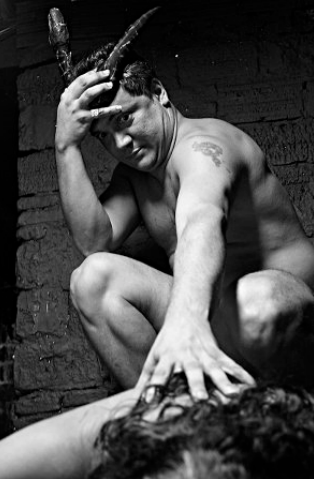 Jorge Bandeira onstage in his nude production,
Jorge Bandeira onstage in his nude production, The Major Arcana
Last year (2023), the non-landed naturist group that Jorge Bandeira founded in Manaus celebrated an important twenty-year milestone. Grupo Amazônico União Naturista (GRAUNA) has been hosting events and normalizing naturism in the Manaus area for two decades now. As part of the celebration, Jorge launched the first-ever translation into Portuguese of William Welby’s trilogy of books on naturism, first published in England in 1934. In spite of relatively sparse attention from naturist historians, Welby’s books were reprinted and updated several times through the mid twentieth century. The original three titles–Naked and Unashamed; The Naked Truth About Nudism; and It’s Only Natural: The Philosophy of Nudism–now appear in one volume with the Portuguese title A Trilogia do Naturismo, translated by Jorge Bandeira and Mayara Campos, published by Metaphora Editorial, and with a striking cover representing water on skin.

In Bandeira’s introductory materials (initially published in the early 2000s over several issues of the erstwhile magazine Brasil Naturista), he praises Welby’s concise prose while highlighting the English writer’s insistence on the physical and psychological benefits to be reaped from naturism, or “nudism” as Welby more consistently named it. Bandeira also remarks on the stunning beauty of the photographs included in the original volumes, the majority of which were taken by Walter Bird.
Bandeira insists that Welby was ahead of his time, since he advocated for the “solar vitamin” we know now as vitamin D, especially regarding its role in the regular function of the endocrine glands. Welby also fought back against religious conservatives who viewed nudism as immoral, and against Henry Ford and others who championed motors over legs and photography over eyes. Yet Welby was not dogmatic, affirming that although many nudists were vegetarian, there were also plenty who ate meat, and plenty who smoked or drank alcohol; what was important was moderation. He condemned the practice of linking nudism to some sort of idealized eugenics.
 “Translation of William Welby’s Nudism Trilogy successfully completed!”
“Translation of William Welby’s Nudism Trilogy successfully completed!”For Welby, social nudism caused no harm to peoples or societies; on the contrary, nudism restored aspects of humanity that had been lost to the false morality of textiles. For example, Welby saw body acceptance issues–which he called an inferiority complex–as the direct result of societal expectations around clothing. For such issues and many other psychological diagnoses, Welby proposed naturism as highly beneficial, if not an outright cure – a proposition that recent research by psychologist Keon West, for example, strongly supports (example 1, example 2)
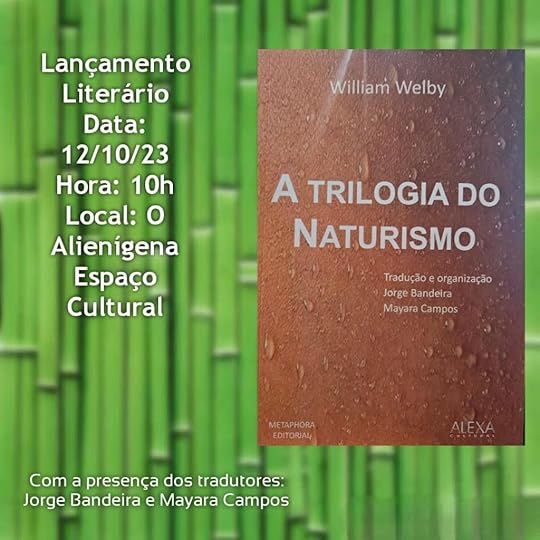 The book launch poster
The book launch posterBandeira quotes from the conclusion of the third volume regarding what Welby predicted for the future of naturism:
Eu não vejo com bons olhos o futuro do Nudismo somente em grupos isolados, como se fossem sociedades secretas. Se você é nudista, as pessoas irão lhe respeitar pelo seu bom senso e cordialidade, por sua conduta moral e ética, esteja você nu ou com roupas, o tratamento será o mesmo. O futuro do Nudismo, então, depende única e exclusivamente das atitudes dos nudistas. Se existir uma fraternidade e cooperação dentro do movimento nudista, a esperança é que tenhamos um futuro próspero.
William Welby, from the conclusion to The Naked Truth About Nudism, trans. Bandeira and Campos
Here’s my translation from Portuguese back into English:
“I don’t see a good future for Nudism if it’s only in isolated groups, as if they were secret societies. If you are a nudist, people will respect you for your good sense and cordiality, for your moral and ethical conduct; whether you are nude or clothed, the treatment will be the same. The future of Nudism, then, depends only and exclusively on the attitudes of nudists. If there can exist a fraternity, a cooperation within the nudist movement, then the hope is for us to have a prosperous future.”
In another paragraph, Welby does add that the future of nudism also hinges on the actions of non-nudists; in any case, the need for cooperation among nudists, naturists, nude-friendly folk, and our allies certainly still holds true today.
This first-ever translation to one of the world’s most spoken languages is a triumph for organized naturism in the Lusophone (Portuguese-speaking) world. Bandeira and Campos have given to Welby’s naturist classics from the temperate British Isles, a new voice for warmer nations of the Mediterranean and the tropics such as Brazil, Portugal, Angola, and Mozambique.
Jorge Bandeira is an outstanding naturist leader, activist, artist, and scholar. For more about his naturist art, theater, and writings, see my posts on an exhibit and performance on Indigenous traditions he did at Ecoparque da Mata, an exhibit he organized based on Kahlil Gibran’s The Prophet, and the celebrations and exhibits for GRAUNA’s 15th anniversary in 2018.
September 27, 2023
Talking about Naturist Fiction
It’s always a pleasure to have a conversation about naturism and naturist fiction. I recently had the opportunity to do just that with Frank Stone, host of the podcast Naked, Nudists and Naturists. Frank is a terrific interviewer who does a solid show, and he’s divided the interview into two parts. The first part came out last Saturday, and the second part comes out this Saturday. You can listen to both parts on the various podcast services or from their own site, Episodes 13 and 14 (September 23 and 30, 2023) along with all their other great episodes!

I was also interviewed by Evan Nix for Scott Cline’s New Nudist Podcast, another excellent choice for naturists and nudists. The episode aired last year, and I was remiss in posting about it, so I’m happy to send interested listeners now to Episode 22 (June 13, 2022), along with all their other compelling content! Evan is not only an outstanding interviewer, but also an attentive reader and an accomplished podcaster himself with his program Naked Age.

I look forward to talking with my fellow writer of naturist fiction, DH Jonathan, while we sell and sign our books at the annual arts festival at Oaklake Trails on October 14. The titles we’ll be selling can be seen in the top image on this post – his three, my three, and the four naturist anthologies I’ve co-edited with Ted Bun that feature short stories by more than a score of naturist writers from different areas of the world. DH Jonathan was also interviewed on Naked, Nudists and Naturists (Episodes 7 and 8), and Ted Bun’s interview has already been recorded and will hopefully be on the air soon!
Collaboration is key for all of us naturist content creators. It’s wonderful to work with such talented writers, podcasters, artists and more, and we all win, perhaps most especially the consumers of our work who become more aware of the high quality and wide variety of naturist content that’s available.
June 22, 2023
Normalizing Nudity to Fight Crime
This is a difficult post to write. It’s about extortion, suicide, and grief. I’m compelled to write it, however, because it’s also about nudity, nude photos, and a perhaps unexpected way for us naturists, nudists and our allies to bring about positive change.
Last month, national headlines here in the US declared that a South Carolina state representative sponsored a bill to crack down on criminals who blackmail people online, especially teenagers. The representative’s 17-year-old son had been a victim, and had committed suicide because of the criminals’ threat.
What was the threat? Pay us, or we release your nudes all over the Internet.
How did they get his photos? They pretended to be a young woman sending him her nudes and asking for his in return.
He sent them the $25 in his Venmo account, begged for time… and then shot himself. After his death, his family members started receiving hateful messages from these criminals, and blinked through the tears of their anguish to gradually piece together what had happened. There are several articles online about the incident – a thorough one from CNN can be found here.
The legislation passed unanimously, and the South Carolina governor signed it, and that’s great and as it should be. My heart goes out to the family of this young man. They did not let their grief keep them from action. I admire the representative’s bravery in letting his son’s case be known, and for using his position to do something about it. What the criminals did is heinous, despicable, unspeakably cruel, and they should be prosecuted to the full extent of the law.
Unfortunately, such cases appear to be on the rise, particularly regarding victimization of young men. From the CNN article:
In 2022, law enforcement agencies received over 7,000 reports related to the online sextortion of minors, federal officials say. Nearly half of those resulted in victims, a majority of them boys. Over a dozen of the sextortion victims died by suicide, the FBI says.
https://www.cnn.com/2023/05/13/us/brandon-guffey-gavin-sextortion-law-cec/index.html
Right here in my city, a friend’s coworker’s son, of the same age, recently committed suicide, and I’m left wondering if something similar happened to him.
Here’s where this gets a little blurry, from a naturist perspective: I don’t know, nor do I care to know, whether the young man’s photos were merely nudes, or if they were in some way sexually explicit. Let’s also acknowledge that the victim in South Carolina may well have felt shame not just because of the nudes, but also for having fallen for the scam and for implicating his family and friends. To be sure, it would be a complicated range of emotions that only the victim would have been able to attempt to articulate precisely. What I would like to argue, in any case, is that normalizing nudity has an immense power here – the potential to take away, or to greatly reduce, the shame felt by this young person and by many others like him. We’ve all heard that line about ‘I’d rather die than anybody see me naked.’ It’s really not very funny at all. It was terribly, horrifically true in this case.
Five years ago, there was an internationally recognized organization dedicated to helping victims of revenge porn called the BADASS Army – BADASS as an acronym for Battling Against Demeaning and Abusive Selfie Sharing. It was founded by Katelyn Bowden and BeLinda Berry, who had both experienced having their nudes uploaded to a pornographic site without their consent. The group helped many victims seek legal counsel and psychological help. Often, those who became active in the group no longer saw themselves as victims but rather as activists and badasses.
“Another former-victim-turned-activist was invited to represent BADASS at Facebook headquarters because they became an international expert on digital exploitation and digital self-advocacy as a result of their experience.”
Kalish, Rachel. Young Adult Sexuality in the Digital Age. p. 45. Online quote source.
There are quite a few articles online, from 2018 and 2019, about the group and its mission (two good examples here and here). At the time of this writing, however, their website no longer exists, and the Twitter account has been inactive since a September 2020 posting about a leadership shake-up. Those seeking help are redirected to the Cyber Civil Rights Initiative and March Against Revenge Porn (no site found).

I support the new anti-sextortion law in South Carolina and similar legal measures, and I support the BADASS mission in whatever form it has taken. What I want to add to the conversation is that a way of getting at the root of the problem, and gnawing away at its power to exist in the first place, is to continue to normalize nudity. I’m reminded of a very popular magazine among European teens, Bravo, that profiles young Germans, with their names and interests and hobbies and etc. alongside a full nude photo.
“We take this very seriously,” said Bravo’s deputy editor-in-chief, Alex Gernandt. “It is not pornography. It deals with naked people, but in a very sensitive way. We try to portray young people to tell readers, ‘You are not too fat, not too thin. You are OK the way you are.’ “
[…]
Each weekly issue of Bravo now features photos of two nude teenagers — male and female, generally between the ages of 16 and 20. The feature is called “That’s Me,” and the pictured teenagers talk about their bodies and their experiences with love and sex.
They are paid a little more than $500 to pose, and many report a self-esteem boost from the experience, von Arx said.
https://www.seattletimes.com/nation-world/teen-magazine-with-nude-pics-yes-in-germany/
What a stark contrast! In fact it seems like the opposite scenario from the sextortion cases. [Note: The article quoted above is from 2006. According to the Wikipedia article on Bravo, the age for the people in the nude feature has changed to 18-25 since the 2010s.] Might there be sextortion victims in Germany? Sure, but probably a lot fewer in proportion. Is there criticism of Bravo magazine’s nude feature? Yes, there has been, and it led to the older age limits, among other changes that directly address the models’ consent (such as allowing the models to take the photos themselves by using a remote clicker for the camera). Is it realistic to think the United States could adopt this kind of open attitude as a part of its mainstream culture anytime in the near future? Well, no. No, it is not realistic, certainly not as things stand right now.
And yet there does seem to be movement, acceptance, and some change in understanding about nudity. But we have to work a lot harder to help the change happen, and it’s something that we naturists are uniquely positioned to do! We have to work harder to show that being comfortable with your own nudity is a way of owning it, a way of making it much more difficult for someone else to appropriate it or extort it, even without specific consent.
 #normalizenudity #normalisenaturism
#normalizenudity #normalisenaturism What if we lived in a world where a nude is just another kind of selfie, where wearing nothing is simply another wardrobe choice? A world where we encourage people to spend time naked outdoors, just as we encourage them to eat their vegetables and exercise… Normalizing nudity can, in fact, reduce not only shame but also crime – and not just sextortion crime, because eventually normalizing nudity can lead to eliminating the so-called “crime” of public nudity. Naturism is no panacea, but we need to be mindful about promoting all the good it can do. Our bodies and our societies will be so much healthier.
February 11, 2023
Avocados and the Nude World
It’s the time of year for Super Bowl ads, and there’s a fun one that has a great nude-friendly message. Avocados From Mexico produced an Adam and Eve spoof, “Make It Better,” that reimagines the famous scene in the Garden of Eden and leads to… well, a whole nude world.
Eve has bitten into a fruit (we don’t see which), the sky darkens, and Adam cries out in panic, “I’m naked!” Not to fear, says a squirrel (or maybe a prairie dog?), who hands Eve an avocado, which she opens into an aura of golden light. Then we fast-forward to present-day New York City, now known as The Big Avocado, where everyone is going about their lives in the nude. We see people of many shapes, sizes and colors. Of course the shots are framed such that no genitals or breasts are visible. Peace reigns. All is love and light. Somehow Adam and Eve and the squirrel are still around, and they have the last words. Looking at a nude Statue of Liberty, the squirrel says “Sweet liberty” and Eve quips, “Now that’s a tourist attraction.”
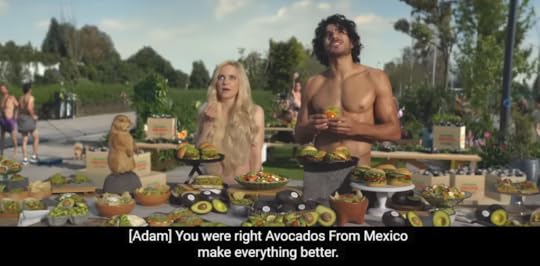 Screenshot from “Make It Better,” Avocados from Mexico Super Bowl ad 2023
Screenshot from “Make It Better,” Avocados from Mexico Super Bowl ad 2023On the surface, it’s a silly commercial that relies on humor and nudity to grab the viewer’s attention and, hopefully, sell more avocados, precisely at the time of the year when avocado sales peak for the Super Bowl. Holy guacamole!
Ah, but there’s more to it than that, says I. Let’s unpack this a bit. The commercial’s message is essentially “change the narrative.” It seems to be as easy as changing which fruit you pick – had Eve simply picked an avocado, the world would be a very different, naked, place. “Sweet liberty,” indeed. That the narrative that should be changed is none other than Genesis is very interesting – Genesis, and by extension, the entire Bible: the cornerstone of the Western worldview.
Here’s the thing: the Middle Easterners who produced the books of the Old and New Testaments had no idea what an avocado is. It’s a plant native to what sixteenth-century Europeans would call the New World, or the Western Hemisphere. Just like corn, potatoes, tomatoes, cacao, chilies, squashes, peanuts, most beans, pineapples, blueberries, etc., avocados were unknown to anyone outside the Americas until the colonial period.
Those who did know about avocados – namely, the Indigenous peoples of the tropical Americas – had their own customs and practices concerning clothing, but were on the whole much more nude-friendly than those Old World invaders. Is there a correlation? Yes -the tropical climate is propitious for certain plant and animal species, and also for not wearing so many damn clothes.
And this is why the ad is actually very clever – the “New World” could have been the “Nude World” if the Europeans hadn’t been so dogmatic about their way of seeing things. Indigenous artists who were trained in European-style painting during the colonial period painted Garden of Eden scenes on the walls and ceilings of chapels throughout Latin America. In them, nude Eve and Adam appear among local species like toucans, macaws, cacao trees and, yes, avocado trees. Those artists adopted stories from afar to local landscapes. They painted the world as they knew it. Don’t we all?
Unpacking a bit more, it’s worth pointing out that the English word “avocado” comes from “ahuacatl” in Nahuatl, the language of the Mexica (Aztecs) and many other peoples, still spoken today. The word in Nahuatl means not only avocado, but also testicle, due to the resemblance between the fruit and the organ. Some Indigenous traditions regard avocados, and chilies, as aphrodisiacs (more here). Even without the avocado in the mix, there are many who interpret the “fruit” in Genesis to refer to the genitals and sexual knowledge. Yet, to its credit, the Avocados From Mexico ad does not get any closer to a sexual tone than a general “oh look they’re naked” titillation.
Anything that helps people associate social nudism with happiness is a good thing, in my view. The “change the narrative” message works very well in this memorable, green, natural little piece of propaganda. After all, it isn’t so much that Eve needed an avocado. It’s that our Western worldview needs to lighten up and drop the clothes!
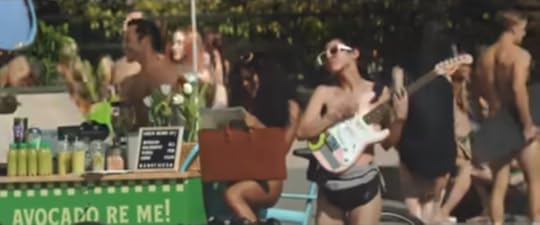 Screenshot from “Make It Better,” Avocados from Mexico Super Bowl ad 2023
Screenshot from “Make It Better,” Avocados from Mexico Super Bowl ad 2023
December 30, 2022
Embodiment and Imagery
As 2022 comes to an end, I reflect back on the Green Man, the ancient European archetypal figure who began to appear in my thoughts and writings last year, and to whom I dedicated a series of posts this past summer. The Green Man can be seen as an embodiment of the male archetypes. He is also a representation of the harmony of man in nature – something of a naturist icon.
A year ago, I started letting my beard grow out, and I was joking that I would be Merlin, Gandalf or Dumbledore for Halloween. So with that in mind, on a day in late October when I was at the nearby naturist park, I decided to capture some images of myself in the woods, wearing only a robe that looks something like a wizard’s cloak. I found a long stick to use as a staff, set up the timer function on my phone’s camera, and struck some poses. I was very pleased with the outcome. The images show me embodying the Wizard archetype, if not exactly that of the Green Man himself. The way I’m holding the staff in some of the images also recalls the Warrior archetype. The robe covers me, but only partially – many would consider these images to be “nudes.” But to whatever degree there is nudity in these photos, it represents strength and power, even as it also represents vulnerability. I posted a couple of the photos on Twitter and received a fair amount of positive feedback. For me, the overall experience was empowering.

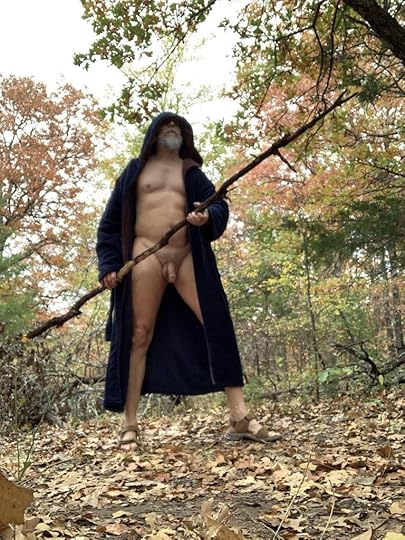
The following month, on a family visit to Mexico, my wife snapped a photo of me while I was admiring the bougainvillea over the top of the curtains in the window of a colonial-era inn where we were staying. I had just gotten out of bed, so I was naked, but because of the play of light and because the photo is taken from behind, there is not much of me to see. I liked the image and so I posted it to my Twitter account, where it proceeded to rocket past any image I had ever posted for a record number of likes. I wondered, and still wonder, quite why the image garnered so much attention, even though I’m mostly convinced by a friend’s explanation that it’s precisely the mystery of the darker parts of the image that makes it interesting.

There are quite a few prominent naturist influencers on social media who post many more images of themselves than I do. I’m thankful for their representation. Representation matters. I’m proud to do what I can to help embody naturism, along the lines of the #IAmTheFaceOfNaturism hashtag started by AANR-West representative Linda Weber. Showing the world that you don’t need to wear clothes in the kitchen or out on a boat may seem humdrum for naturists, but for all those not-yet-naturists, it can be a groundbreaking epiphany. What I’m thinking about here are the ways in which, through this kind of imagery, it is not only naturism or nudism that is being embodied, but also, at least sometimes, the archetypal relationship of humanity with nature. Some of the most important rituals or rites of passage in the world’s oldest cultures were, and still are, performed nude to maximize our unity with the force of nature that we all represent. In the end, maybe what makes nudity so powerful, and even what makes it paradoxically so mysterious even though everything is exposed, is that through nudity, through naturism, we embody nature even as we dissolve into it. We are archetypal, we are natural, and never more so than when nude.
July 28, 2022
The Archetypes in the Green Man
This is the eighth and final mystery reading in the Green Man series – brief texts that illuminate aspects of masculinity through nature while exploring the major masculine archetypes.
A central truth about the archetypes is that they all reside within each one of us. You may feel more drawn toward one than the others, but it’s important to be aware of them all in their particular relevance and resonance to you. You may cycle through them during different periods of your life or under different circumstances.
We can see this in the Green Man, the organizing principle for these posts. In him we can divine the five archetypes as outlined. He is the King of the Forest as well as its Father figure. He can protect and defend the forest as a Warrior. His secrets of growth, decay and renewal embody both the alchemy of the Wizard and the earthy sensuality and creativity of the Lover.
 An image of the Green Man / Horned God / Cernunnos with an overlay of the chakras. Image source on right side.
An image of the Green Man / Horned God / Cernunnos with an overlay of the chakras. Image source on right side.The image above, of chakras overlaid onto the Green Man or Horned God, invites an assignment of archetypes to chakras. It’s a little off because of the numbering, but perhaps the following interpretation holds: The Warrior fits the root (red) chakra covering basic needs such as safety and stability, while the Lover fits the orange sacral chakra of creativity and reproduction. The Father encompasses both yellow (solar plexus) and green (heart) as a central, uniting archetype that builds on both responsibility and love from both Warrior and Lover. The Wizard resides in the blue throat chakra of speaking, singing and spellcasting. The King is centered in the purple or third-eye chakra of perception and wisdom, while the Green Man himself, at least in this image, grows organically right through the crown chakra into fruiting branches that are also antlers – an outreach beyond the self into the environment, into the universe.
In conclusion, and bringing this series back to the naturist Green Man Group that provided the original inspiration, these archetypes are nude. We may associate certain accoutrements with them, such as a staff for the Wizard, a sword for the Warrior, and a scepter for the King, but in their pure essence they are nude, just like the Green Man in the image above. They unite the body and soul with the universe, and as such they are unencumbered, unfettered, exposed and direct. We have but to meditate on their primal mysteries to call them into consciousness, to embody them into being, within us and among us.
July 20, 2022
The Dream of Love and Freedom
This is the seventh mystery reading in the Green Man series – brief texts that illuminate aspects of masculinity through nature while exploring the major masculine archetypes. It’s a different kind of mystery reading, because it’s the narration of a dream:
In the dream, the old man spoke to me of love, and of freedom. He was a wizard of full white beard, and at the same time he was a golden, strapping youth, cloaked in the sun. He said:
“My mind is free, because each day I can choose to learn and to grow in love.
My heart is free, for I love across genders and numbers.
My body is free, because I seek the ways to keep it uncovered.
My spirit is free to roam among cultures and scriptures without confinement to one.”
After he told me this, he handed me his staff even as he disappeared inside of it.
The old man, the young man, the staff, the dream, and I, are all one.
 Wizard of the Woods. Source unknown.
Wizard of the Woods. Source unknown.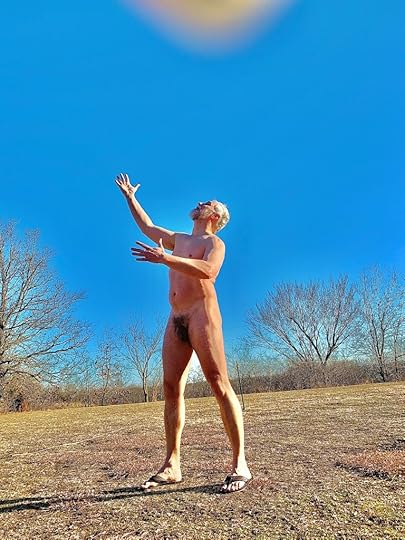 “Summoning the Sun”
“Summoning the Sun”

